Soy Isoflavone Genistein Inhibits an Axillary Osmidrosis Risk Factor ABCC11: In Vitro Screening and Fractional Approach for ABCC11-Inhibitory Activities in Plant Extracts and Dietary Flavonoids
Abstract
1. Introduction
2. Materials and Methods
2.1. Materials
2.2. Preparation of Plant Extracts
2.3. Cell Culture
2.4. Preparation of ABCC11-Expressing Plasma Membrane Vesicles
2.5. Immunoblotting
2.6. Vesicle Transport Assay
2.7. Fractionation of Soybean (Glycine max) Extract
2.8. Chemical Characterizations
2.9. Calculation of the Half-Maximal Inhibitory Concentration Values
2.10. Statistical Analysis
2.11. Availability of Data and Material
3. Results
3.1. Confirmation of ABCC11-Mediated Transport Activity
3.2. Screening the ABCC11-Inhibitory Activities of Plant Extracts
3.3. Fractionation and Isolation of Glycine Max (Soybean) Extract by Chromatographic Separations
3.4. Structural Characterization of the Putative ABCC11 Inhibitor Derived from Soybeans
3.5. Identification of the Active Ingredient as Genistein
3.6. Investigation of ABCC11-Inhibitory Activities of Other Dietary Flavonoids
4. Discussion
5. Conclusions
Author Contributions
Funding
Acknowledgments
Conflicts of Interest
Appendix A
| Descriptions in this Study | Common Names | Academic Names | Details of Material * |
|---|---|---|---|
| Arctium lappa root | Burdock root tea | Arctium lappa | Dried root for tea |
| Aspalathus linearis leaves | Rooibos tea leaves | Aspalathus linearis | Dried leaves for tea |
| Barley (Hordeum vulgare) miso | Barley miso | Hordeum vulgare# | Japanese traditional fermented product |
| Citrus aurantiifolia peel | Lime | Citrus aurantiifolia | Peel |
| Citrus depressa peel | Shikuwasa | Citrus depressa | Peel |
| Citrus junos peel | Yuzu | Citrus junos | Peel |
| Citrus maxima peel | Pomelo | Citrus maxima | Peel |
| Citrus maxima placenta | Pomelo | Citrus maxima | Inner white and soft tissue layer |
| Citrus natsudaidai peel | Suruga elegant | Citrus natsudaidai | Peel |
| Citrus reticulata var poonensis peel | Ponkan | Citrus reticulata var. poonensis | Peel |
| Citrus sinensis peel | Blood orange | Citrus sinensis | Peel |
| Citrus sphaerocarpa peel | Kabosu | Citrus sphaerocarpa | Peel |
| Citrus sudachi peel | Sudachi | Citrus sudachi | Peel |
| (Citrus unshiu × Citrus sinensis) × Citrus reticulata peel | Siranuhi (Dekopon) | (Citrus unshiu × Citrus sinensis) × Citrus reticulata | Peel |
| Citrus × Paradisi peel | Grapefruit | Citrus × Paradisi | Peel |
| Citrus × Tangelo peel | Mineola orange (Tangelo) | Citrus × Tangelo | Peel |
| Commercially available lemon juice A | Not available | Not available | Commercially available product ‡ |
| Commercially available lemon juice B | Not available | Not available | Commercially available product ‡ |
| Commercially available lemon juice C | Not available | Not available | Commercially available product ‡ |
| Ditrus sinensis Osbeck var. brasiliensis Tanaka peel | Navel orange | Ditrus sinensis Osbeck var. brasiliensis Tanaka | Peel |
| Fortunella peel | Kumquat | Fortunella | Peel |
| Glycine max | Soybeans(yellow soybean) | Glycine max | Dried product |
| Hidenmame (Glycine max) | Soybeans(green soybean) | Glycine max | Dried product |
| Humulus lupulus L. cone | Hop | Humulus lupulus L. | Frozen hop cone |
| Ilex paraguariensis leaves (roasted) | Yerba mate tea leaves | Ilex paraguariensis | Dried and roasted leaves for tea |
| Jasminum polyanthum leaves | Jasmine tea leaves | Jasminum polyanthum | Dried leaves for tea |
| Matricaria recutita | Chamomile | Matricaria recutita | Dried herb product |
| Prunus domestica extract | Prune extract | Prunus domestica | Product of prune pulp extract ‡ |
| Prunus domestica pulp | Prune | Prunus domestica | Product of prune pulp without seed |
| Psidium guajava leaves (from China) | Guava tea leaves | Psidium guajava | Dried leaves for tea cultivated in China |
| Psidium guajava leaves (from Japan) | Guava tea leaves | Psidium guajava | Dried leaves for tea cultivated in Japan |
| Rice (Oryza sativa) miso | Rice miso | Oryza sativa# | Japanese traditional fermented product |
| Smallanthus sonchifolius tea powder | Yacon tea powder | Smallanthus sonchifolius | Dried product |
| Soybean (Glycine max) miso | Soybean miso | Glycine max# | Japanese traditional fermented product |

References
- Inoue, Y.; Mori, T.; Toyoda, Y.; Sakurai, A.; Ishikawa, T.; Mitani, Y.; Hayashizaki, Y.; Yoshimura, Y.; Kurahashi, H.; Sakai, Y. Correlation of axillary osmidrosis to a SNP in the ABCC11 gene determined by the Smart Amplification Process (SmartAmp) method. J. Plast. Reconstr. Aesthet. Surg. 2010, 63, 1369–1374. [Google Scholar] [CrossRef] [PubMed]
- Toyoda, Y.; Gomi, T.; Nakagawa, H.; Nagakura, M.; Ishikawa, T. Diagnosis of Human Axillary Osmidrosis by Genotyping of the Human ABCC11 Gene: Clinical Practice and Basic Scientific Evidence. Biomed. Res. Int. 2016, 2016, 7670483. [Google Scholar] [CrossRef] [PubMed]
- Martin, A.; Saathoff, M.; Kuhn, F.; Max, H.; Terstegen, L.; Natsch, A. A functional ABCC11 allele is essential in the biochemical formation of human axillary odor. J. Investig. Dermatol. 2010, 130, 529–540. [Google Scholar] [CrossRef] [PubMed]
- Toyoda, Y.; Sakurai, A.; Mitani, Y.; Nakashima, M.; Yoshiura, K.; Nakagawa, H.; Sakai, Y.; Ota, I.; Lezhava, A.; Hayashizaki, Y.; et al. Earwax, osmidrosis, and breast cancer: Why does one SNP (538G>A) in the human ABC transporter ABCC11 gene determine earwax type? FASEB J. 2009, 23, 2001–2013. [Google Scholar] [CrossRef] [PubMed]
- Nakano, M.; Miwa, N.; Hirano, A.; Yoshiura, K.; Niikawa, N. A strong association of axillary osmidrosis with the wet earwax type determined by genotyping of the ABCC11 gene. BMC Genet. 2009, 10, 42. [Google Scholar] [CrossRef] [PubMed]
- Bortfeld, M.; Rius, M.; Konig, J.; Herold-Mende, C.; Nies, A.T.; Keppler, D. Human multidrug resistance protein 8 (MRP8/ABCC11), an apical efflux pump for steroid sulfates, is an axonal protein of the CNS and peripheral nervous system. Neuroscience 2006, 137, 1247–1257. [Google Scholar] [CrossRef]
- Chen, Z.S.; Guo, Y.; Belinsky, M.G.; Kotova, E.; Kruh, G.D. Transport of bile acids, sulfated steroids, estradiol 17-beta-D-glucuronide, and leukotriene C4 by human multidrug resistance protein 8 (ABCC11). Mol. Pharmacol. 2005, 67, 545–557. [Google Scholar] [CrossRef]
- Yoshiura, K.; Kinoshita, A.; Ishida, T.; Ninokata, A.; Ishikawa, T.; Kaname, T.; Bannai, M.; Tokunaga, K.; Sonoda, S.; Komaki, R.; et al. A SNP in the ABCC11 gene is the determinant of human earwax type. Nat. Genet. 2006, 38, 324–330. [Google Scholar] [CrossRef]
- Toyoda, Y.; Takada, T.; Gomi, T.; Nakagawa, H.; Ishikawa, T.; Suzuki, H. Clinical and Molecular Evidence of ABCC11 Protein Expression in Axillary Apocrine Glands of Patients with Axillary Osmidrosis. Int. J. Mol. Sci. 2017, 18, 417. [Google Scholar] [CrossRef]
- Toyoda, Y.; Takada, T.; Miyata, H.; Ishikawa, T.; Suzuki, H. Regulation of the Axillary Osmidrosis-Associated ABCC11 Protein Stability by N-Linked Glycosylation: Effect of Glucose Condition. PLoS ONE 2016, 11, e0157172. [Google Scholar] [CrossRef]
- Saito, H.; Toyoda, Y.; Takada, T.; Hirata, H.; Ota-Kontani, A.; Miyata, H.; Kobayashi, N.; Tsuchiya, Y.; Suzuki, H. Omega-3 Polyunsaturated Fatty Acids Inhibit the Function of Human URAT1, a Renal Urate Re-Absorber. Nutrients 2020, 12, 1601. [Google Scholar] [CrossRef] [PubMed]
- Toyoda, Y.; Mancikova, A.; Krylov, V.; Morimoto, K.; Pavelcova, K.; Bohata, J.; Pavelka, K.; Pavlikova, M.; Suzuki, H.; Matsuo, H.; et al. Functional Characterization of Clinically-Relevant Rare Variants in ABCG2 Identified in a Gout and Hyperuricemia Cohort. Cells 2019, 8, 363. [Google Scholar] [CrossRef] [PubMed]
- Toyoda, Y.; Takada, T.; Suzuki, H. Inhibitors of Human ABCG2: From Technical Background to Recent Updates with Clinical Implications. Front. Pharmacol. 2019, 10, 208. [Google Scholar] [CrossRef]
- Hirata, H.; Takazumi, K.; Segawa, S.; Okada, Y.; Kobayashi, N.; Shigyo, T.; Chiba, H. Xanthohumol, a prenylated chalcone from Humulus lupulus L., inhibits cholesteryl ester transfer protein. Food Chem. 2012, 134, 1432–1437. [Google Scholar] [CrossRef] [PubMed]
- Miyata, H.; Takada, T.; Toyoda, Y.; Matsuo, H.; Ichida, K.; Suzuki, H. Identification of Febuxostat as a New Strong ABCG2 Inhibitor: Potential Applications and Risks in Clinical Situations. Front. Pharmacol. 2016, 7, 518. [Google Scholar] [CrossRef] [PubMed]
- Chen, K.I.; Erh, M.H.; Su, N.W.; Liu, W.H.; Chou, C.C.; Cheng, K.C. Soyfoods and soybean products: From traditional use to modern applications. Appl. Microbiol. Biotechnol. 2012, 96, 9–22. [Google Scholar] [CrossRef] [PubMed]
- Messina, M. Soy and Health Update: Evaluation of the Clinical and Epidemiologic Literature. Nutrients 2016, 8, 754. [Google Scholar] [CrossRef]
- Mayo, B.; Vazquez, L.; Florez, A.B. Equol: A Bacterial Metabolite from The Daidzein Isoflavone and Its Presumed Beneficial Health Effects. Nutrients 2019, 11, 2231. [Google Scholar] [CrossRef]
- Taylor, P.W.; Hamilton-Miller, J.M.; Stapleton, P.D. Antimicrobial properties of green tea catechins. Food Sci. Technol. Bull. 2005, 2, 71–81. [Google Scholar] [CrossRef]
- Sjostedt, N.; Holvikari, K.; Tammela, P.; Kidron, H. Inhibition of Breast Cancer Resistance Protein and Multidrug Resistance Associated Protein 2 by Natural Compounds and Their Derivatives. Mol. Pharm. 2017, 14, 135–146. [Google Scholar] [CrossRef]
- Tan, K.W.; Li, Y.; Paxton, J.W.; Birch, N.P.; Scheepens, A. Identification of novel dietary phytochemicals inhibiting the efflux transporter breast cancer resistance protein (BCRP/ABCG2). Food Chem. 2013, 138, 2267–2274. [Google Scholar] [CrossRef] [PubMed]
- Li, Y.; Revalde, J.L.; Reid, G.; Paxton, J.W. Interactions of dietary phytochemicals with ABC transporters: Possible implications for drug disposition and multidrug resistance in cancer. Drug Metab. Rev. 2010, 42, 590–611. [Google Scholar] [CrossRef] [PubMed]
- Brand, W.; Schutte, M.E.; Williamson, G.; van Zanden, J.J.; Cnubben, N.H.; Groten, J.P.; van Bladeren, P.J.; Rietjens, I.M. Flavonoid-mediated inhibition of intestinal ABC transporters may affect the oral bioavailability of drugs, food-borne toxic compounds and bioactive ingredients. Biomed. Pharm. 2006, 60, 508–519. [Google Scholar] [CrossRef] [PubMed]
- Xiao, Y.; Zhang, S.; Tong, H.; Shi, S. Comprehensive evaluation of the role of soy and isoflavone supplementation in humans and animals over the past two decades. Phytother. Res. 2018, 32, 384–394. [Google Scholar] [CrossRef] [PubMed]
- Zaheer, K.; Humayoun Akhtar, M. An updated review of dietary isoflavones: Nutrition, processing, bioavailability and impacts on human health. Crit. Rev. Food Sci. Nutr. 2017, 57, 1280–1293. [Google Scholar] [CrossRef]
- Li, N.; Wu, X.; Zhuang, W.; Xia, L.; Chen, Y.; Zhao, R.; Yi, M.; Wan, Q.; Du, L.; Zhou, Y. Soy and Isoflavone Consumption and Multiple Health Outcomes: Umbrella Review of Systematic Reviews and Meta-Analyses of Observational Studies and Randomized Trials in Humans. Mol. Nutr. Food. Res. 2020, 64, e1900751. [Google Scholar] [CrossRef]
- Cao, Z.H.; Green-Johnson, J.M.; Buckley, N.D.; Lin, Q.Y. Bioactivity of soy-based fermented foods: A review. Biotechnol. Adv. 2019, 37, 223–238. [Google Scholar] [CrossRef]
- Rodriguez-Morato, J.; Farre, M.; Perez-Mana, C.; Papaseit, E.; Martinez-Riera, R.; de la Torre, R.; Pizarro, N. Pharmacokinetic Comparison of Soy Isoflavone Extracts in Human Plasma. J. Agric. Food Chem. 2015, 63, 6946–6953. [Google Scholar] [CrossRef]
- Rowland, I.; Faughnan, M.; Hoey, L.; Wahala, K.; Williamson, G.; Cassidy, A. Bioavailability of phyto-oestrogens. Br. J. Nutr. 2003, 89 (Suppl. S1), S45–S58. [Google Scholar] [CrossRef]
- Setchell, K.D.; Brown, N.M.; Desai, P.; Zimmer-Nechemias, L.; Wolfe, B.E.; Brashear, W.T.; Kirschner, A.S.; Cassidy, A.; Heubi, J.E. Bioavailability of pure isoflavones in healthy humans and analysis of commercial soy isoflavone supplements. J. Nutr. 2001, 131, 1362S–1375S. [Google Scholar] [CrossRef]
- Yang, Z.; Kulkarni, K.; Zhu, W.; Hu, M. Bioavailability and pharmacokinetics of genistein: Mechanistic studies on its ADME. Anticancer Agents Med. Chem. 2012, 12, 1264–1280. [Google Scholar] [CrossRef] [PubMed]
- Csanady, G.A.; Oberste-Frielinghaus, H.R.; Semder, B.; Baur, C.; Schneider, K.T.; Filser, J.G. Distribution and unspecific protein binding of the xenoestrogens bisphenol A and daidzein. Arch. Toxicol. 2002, 76, 299–305. [Google Scholar] [CrossRef] [PubMed]
- Fischer, L.; Mahoney, C.; Jeffcoat, A.R.; Koch, M.A.; Thomas, B.E.; Valentine, J.L.; Stinchcombe, T.; Boan, J.; Crowell, J.A.; Zeisel, S.H. Clinical characteristics and pharmacokinetics of purified soy isoflavones: Multiple-dose administration to men with prostate neoplasia. Nutr. Cancer 2004, 48, 160–170. [Google Scholar] [CrossRef] [PubMed]
- Wilke, K.; Martin, A.; Terstegen, L.; Biel, S.S. A short history of sweat gland biology. Int. J. Cosmet. Sci. 2007, 29, 169–179. [Google Scholar] [CrossRef] [PubMed]
- Wang, T.Y.; Li, Q.; Bi, K.S. Bioactive flavonoids in medicinal plants: Structure, activity and biological fate. Asian J. Pharm. Sci. 2018, 13, 12–23. [Google Scholar] [CrossRef] [PubMed]
- Shimizu, H.; Taniguchi, H.; Hippo, Y.; Hayashizaki, Y.; Aburatani, H.; Ishikawa, T. Characterization of the mouse Abcc12 gene and its transcript encoding an ATP-binding cassette transporter, an orthologue of human ABCC12. Gene 2003, 310, 17–28. [Google Scholar] [CrossRef]
- Huser, S.; Guth, S.; Joost, H.G.; Soukup, S.T.; Kohrle, J.; Kreienbrock, L.; Diel, P.; Lachenmeier, D.W.; Eisenbrand, G.; Vollmer, G.; et al. Effects of isoflavones on breast tissue and the thyroid hormone system in humans: A comprehensive safety evaluation. Arch. Toxicol. 2018, 92, 2703–2748. [Google Scholar] [CrossRef]
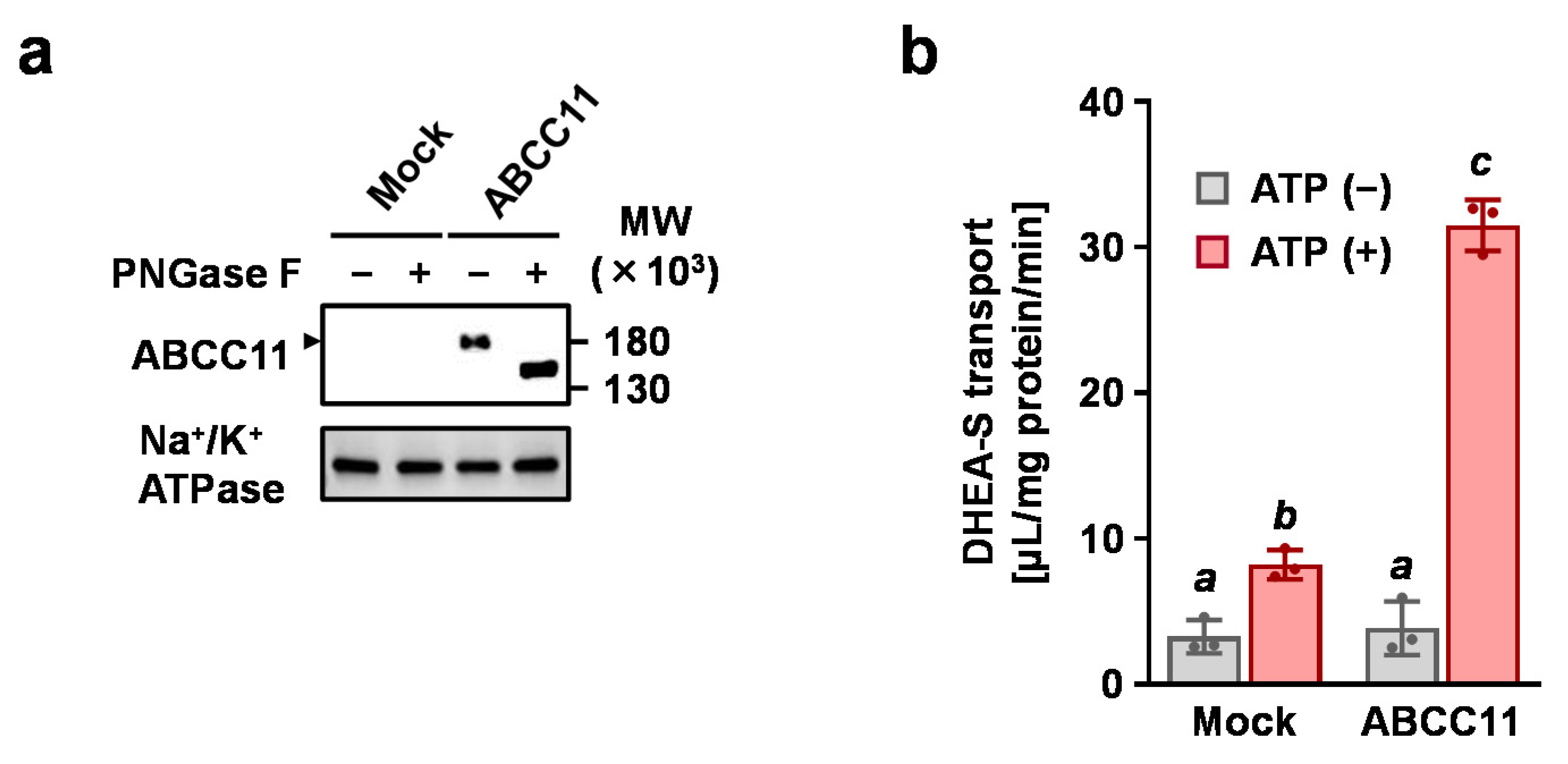
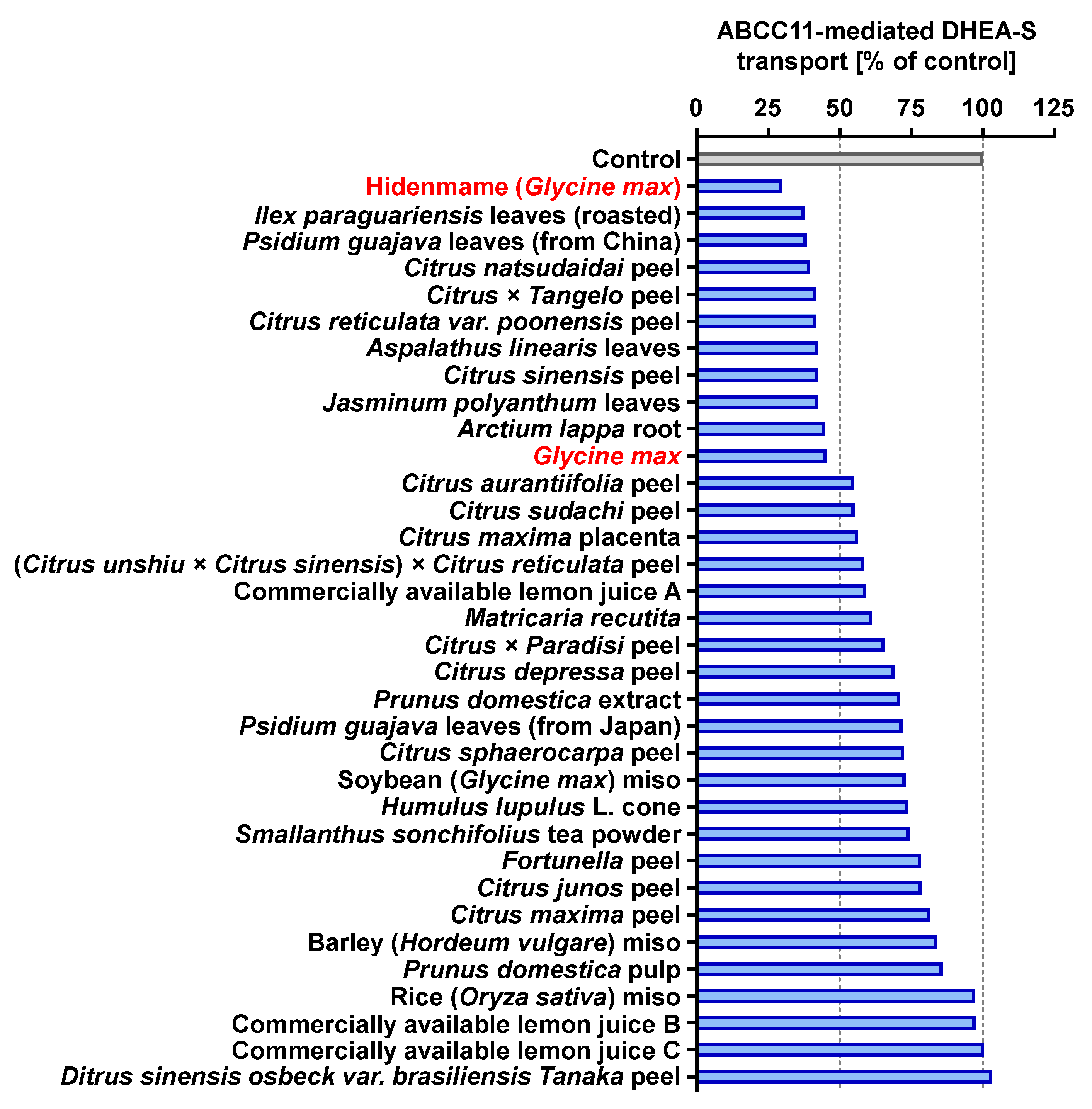
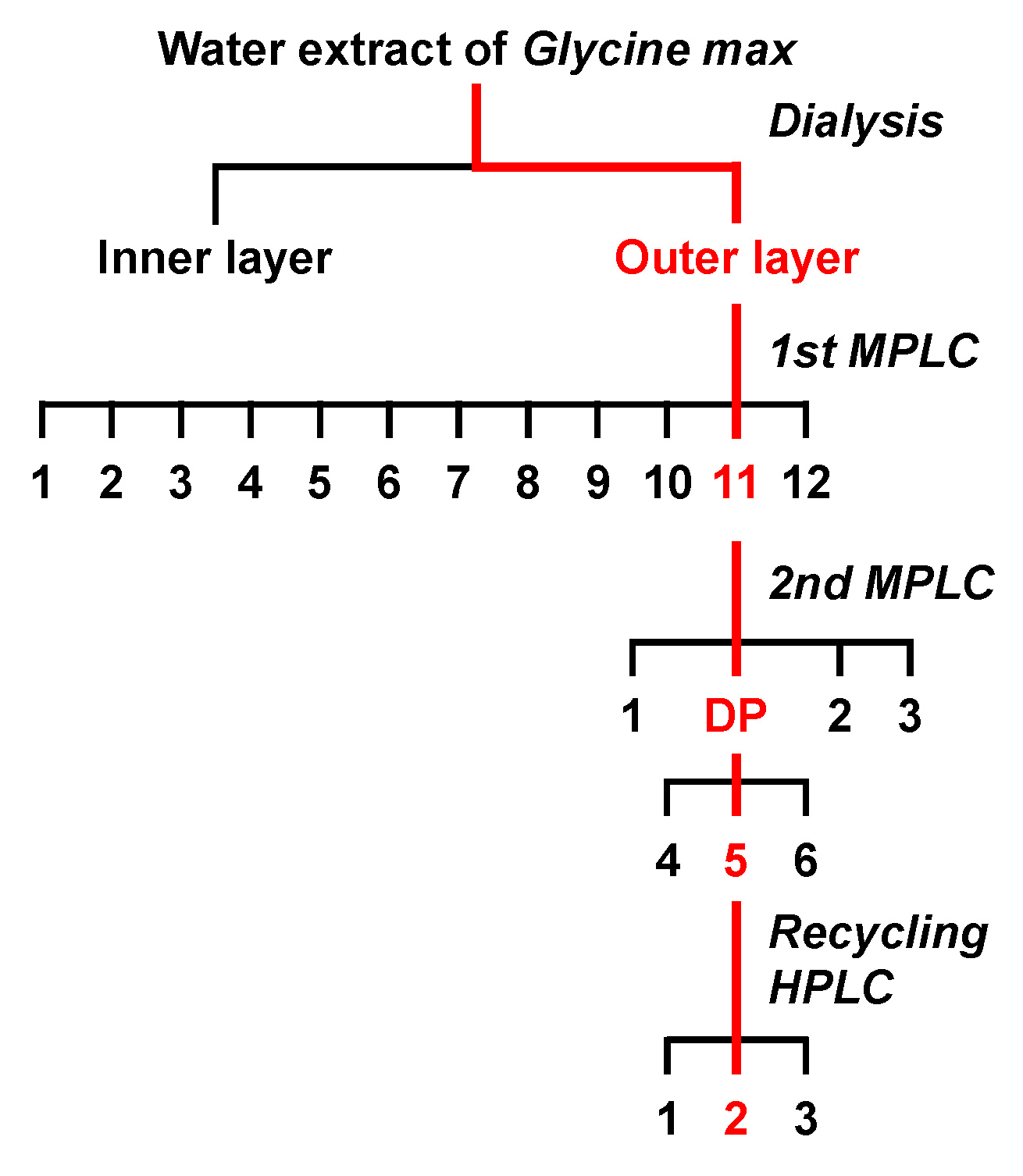
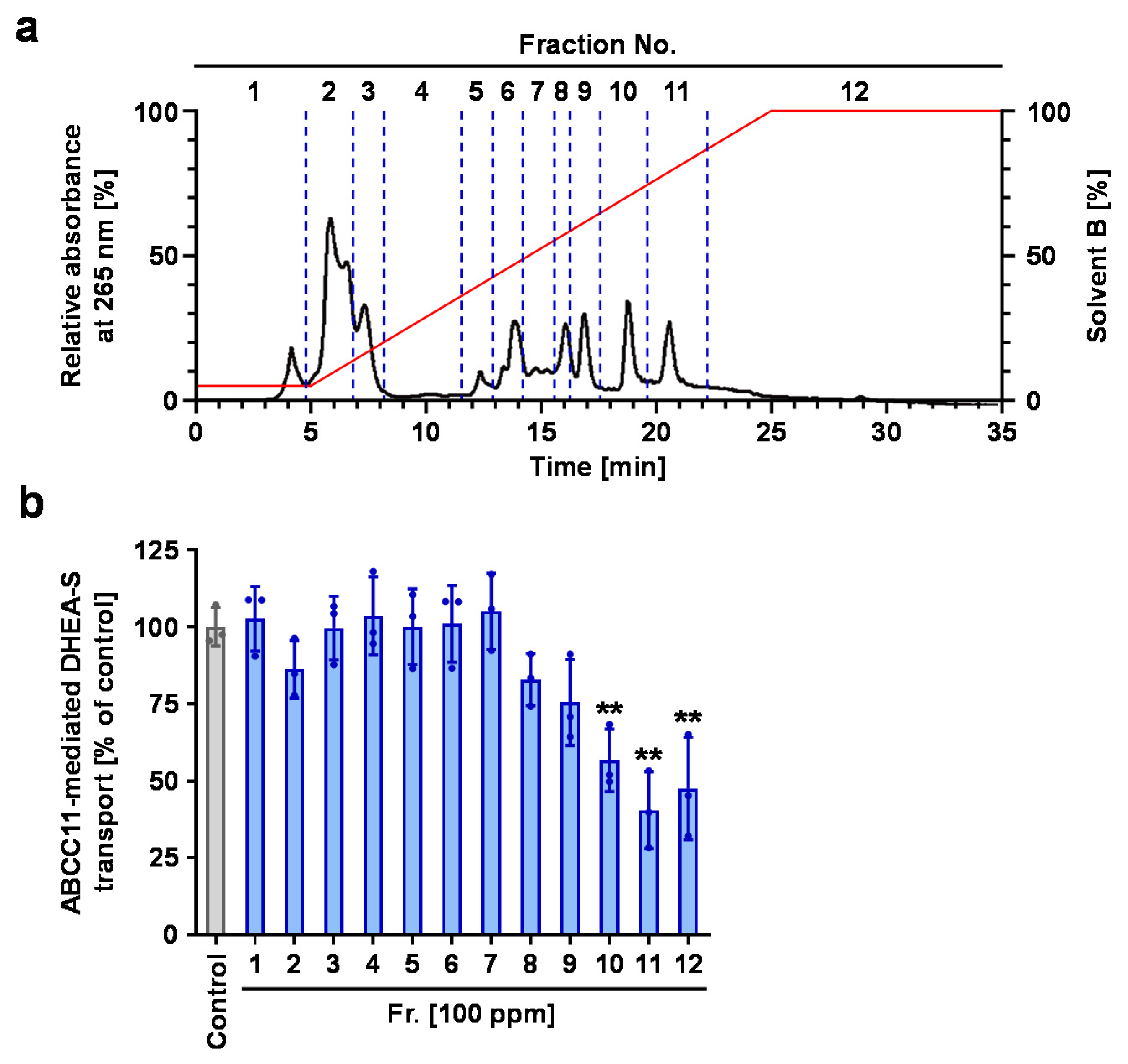
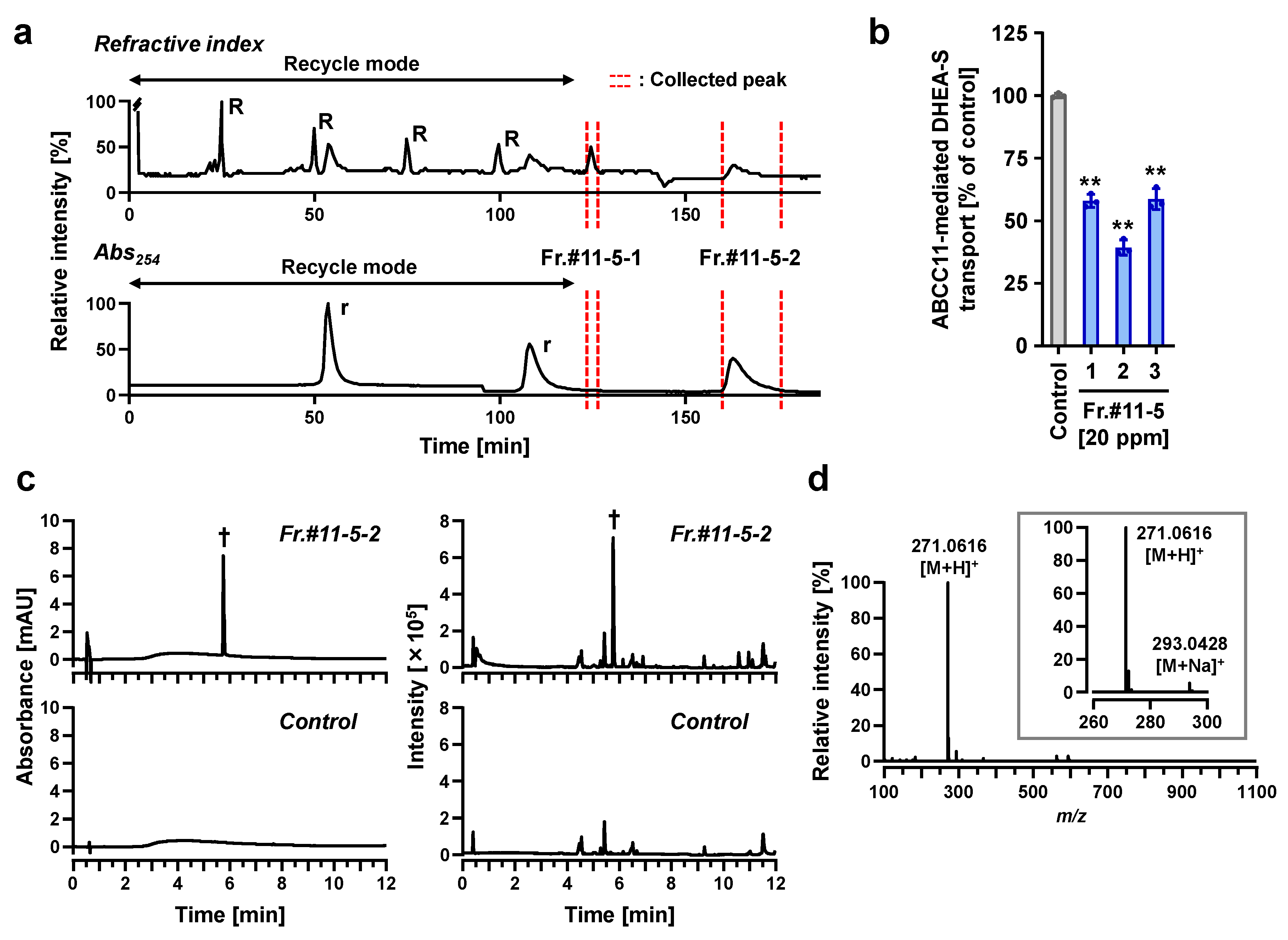
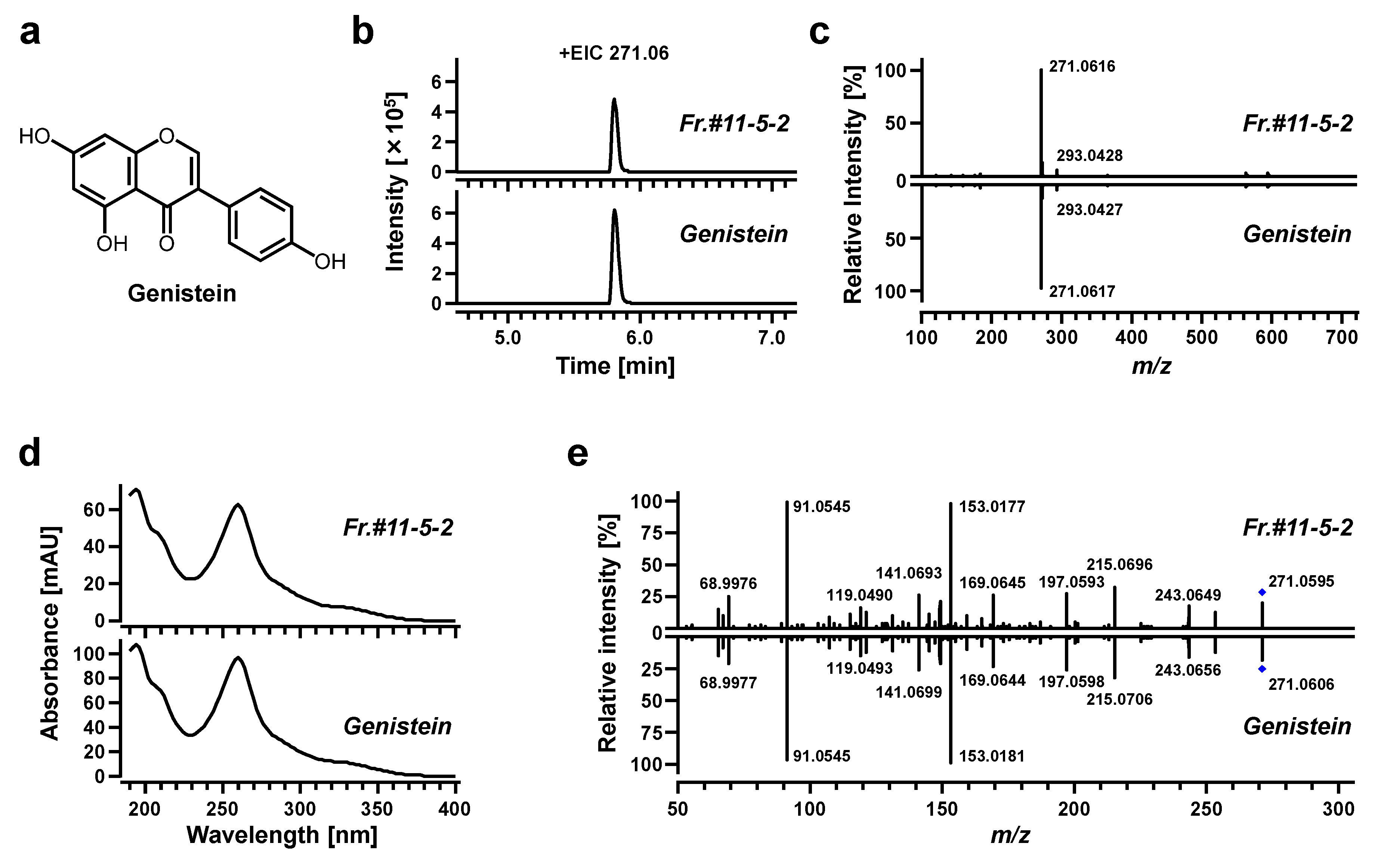
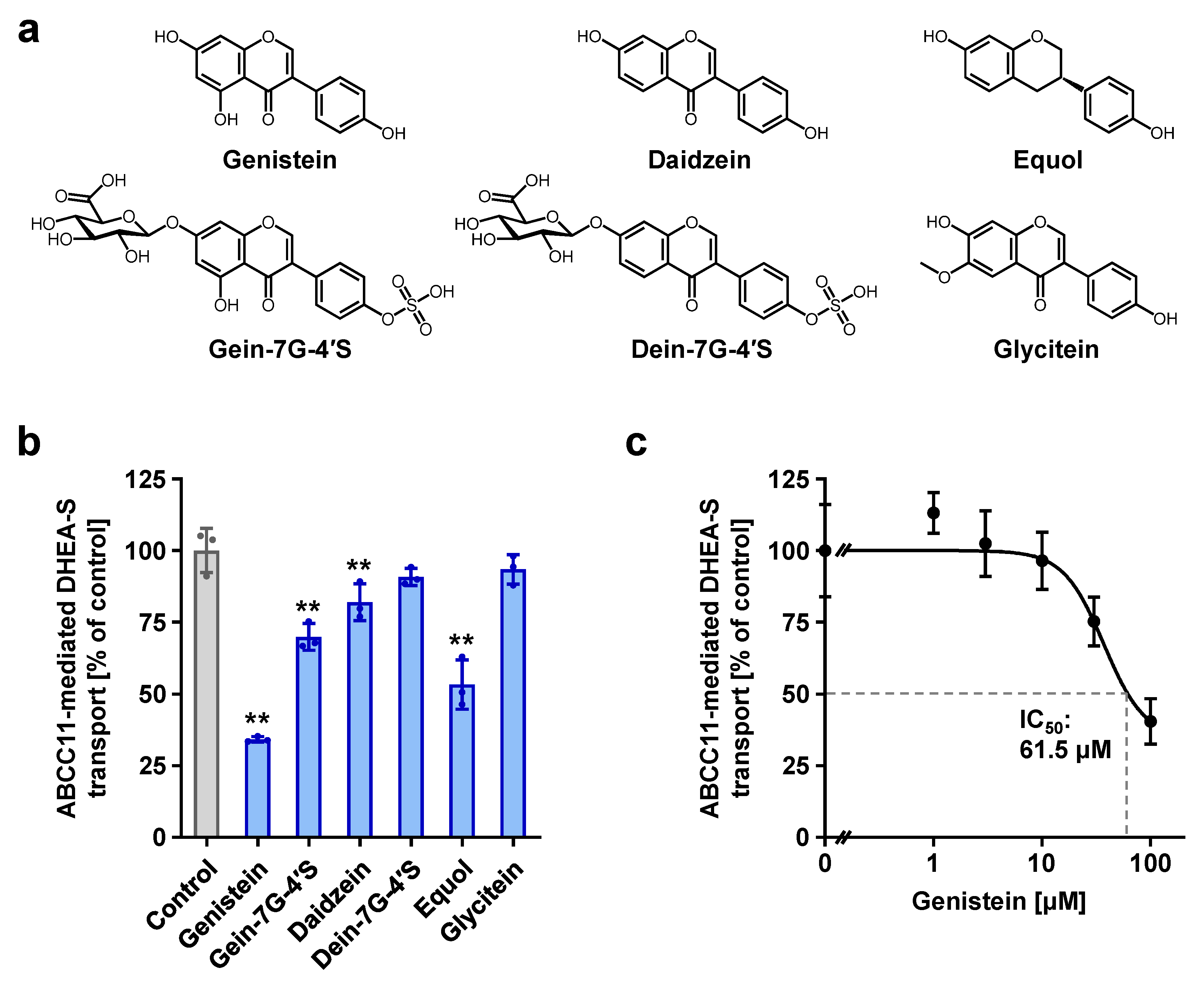
| Reagent or Resource | Source | Identifier |
|---|---|---|
| Antibodies | ||
| Rat monoclonal anti-MRP8 (ABCC11) antibody | Abcam, Cambridge, MA, USA | Cat# ab91452 [M8I-74]; RRID: AB_2049125 |
| Rabbit polyclonal anti-Na+/K+-ATPase α antibody | Santa Cruz Biotechnology, Santa Cruz, CA, USA | Cat# sc-28800; RRID: AB_2290063 |
| Goat anti-rat IgG–horseradish peroxidase (HRP) conjugate | GE Healthcare, Buckinghamshire, UK | Cat# NA935V; RRID: AB_772207 |
| Donkey anti-rabbit IgG–HRP conjugate | GE Healthcare, Buckinghamshire, UK | Cat# NA934V; RRID: AB_772206 |
| Chemicals | ||
| Clear-sol II | Nacalai Tesque, Kyoto, Japan | Cat# 09136-83 |
| Dehydroepiandrosterone sulfate, sodium salt, [1,2,6,7-3H(N)] | PerkinElmer, Waltham, MA, USA | Cat# NET860; 60.0 Ci/mmol |
| Dimethyl Sulfoxide | Nacalai Tesque, Kyoto, Japan | Cat# 13445-74; CAS: 67-68-5 |
| Methanol | Nacalai Tesque, Kyoto, Japan | Cat# 21929-23; CAS: 67-56-1 |
| 3-Hydroxyflavone | Tokyo Chemical Industry, Tokyo, Japan | Cat# H0379; CAS: 577-85-5; Purity: ≥98% |
| Apigenin | FUJIFILM Wako Pure Chemical, Osaka, Japan | Cat# 016-18911; CAS: 520-36-5; Purity: ≥95% |
| Cardamonin | R&D systems, Minneapolis, MN, USA | Cat# 2509/10; CAS: 19309-14-9; Purity: ≥98% |
| Daidzein | FUJIFILM Wako Pure Chemical, Osaka, Japan | Cat# 043-28071; CAS: 486-66-8; Purity: ≥98% |
| Daidzein 7-β-D-glucuronide 4’-sulfate disodium salt | Toronto Research Chemicals, North York, ON, Canada | Cat# D103525; CAS: 1041134-19-3; Purity: N/A |
| Dihydromyricetin | EXTRASYNTHESE, Genay, France | Cat# 1351-10mg; CAS: 27200-12-0; Purity: ≥95% |
| Fisetin | LKT Labs, Minneapolis, MN, USA | Cat# F3473; CAS: 528-48-3; Purity: ≥97% |
| Galangin | ChromaDex, Irvine, CA, USA | Cat# ASB-00007030-010; CAS: 548-83-4; Purity: N/A |
| Genistein | FUJIFILM Wako Pure Chemical, Osaka, Japan | Cat# 073-05531; CAS: 446-72-0; Purity: ≥98% |
| Genistein 7-β-D-glucuronide 4’-sulfate disodium salt | Toronto Research Chemicals, North York, ON, Canada | Cat# G349980; CAS: 176045-29-7; Purity: N/A |
| Glycitein | FUJIFILM Wako Pure Chemical, Osaka, Japan | Cat# 070-04701; CAS: 40957-83-3; Purity: ≥98% |
| Gossypetin | ChromaDex, Irvine, CA, USA | Cat# ASB-00007390-010; CAS: 489-35-0; Purity: N/A |
| Hesperetin | FUJIFILM Wako Pure Chemical, Osaka, Japan | Cat# 320-93841; CAS: 520-33-2; Purity: ≥96% |
| Isoliquiritigenin | Tokyo Chemical Industry, Tokyo, Japan | Cat# I0822; CAS: 961-29-5; Purity: ≥97% |
| Kaempferol | FUJIFILM Wako Pure Chemical, Osaka, Japan | Cat# 110-00451; CAS: 520-18-3; Purity: ≥95% |
| Luteolin | Cayman Chemical, Ann Arbor, MI, USA | Cat# 10004161; CAS: 491-70-3; Purity: ≥98% |
| Morin | Combi-Blocks, San Diego, CA, USA | Cat# QC-0527; CAS: 480-16-0; Purity: ≥98% |
| Myricetin | FUJIFILM Wako Pure Chemical, Osaka, Japan | Cat# 137-16791; CAS: 529-44-2; Purity: ≥98% |
| Naringenin | Tokyo Chemical Industry, Tokyo, Japan | Cat# N0072-5g; CAS: 67604-48-2; Purity: ≥93% |
| Naringenin chalcone | ChromaDex, Irvine, CA, USA | Cat# ASB-00014207-005; CAS: 73692-50-9; Purity: N/A |
| Nobiletin | FUJIFILM Wako Pure Chemical, Osaka, Japan | Cat# 149-09341; CAS: 478-01-3; Purity: N/A |
| Phloretin | FUJIFILM Wako Pure Chemical, Osaka, Japan | Cat# 160-17781; CAS: 60-82-2; Purity: ≥98% |
| Quercetagetin | ChromaDex, Irvine, CA, USA | Cat# ASB-00017020-005; CAS: 90-18-6; Purity: N/A |
| Quercetin | ChromaDex, Irvine, CA, USA | Cat# ASB-00017030-010; CAS: 117-39-5: Purity: ≥97% |
| (S)-Equol | Cayman Chemical, Ann Arbor, MI, USA | Cat# 10010173; CAS: 531-95-3; Purity: ≥98% |
| Taxifolin | EXTRASYNTHESE, Genay, France | Cat# 1036; CAS: 17654-26-1; Purity: N/A |
| Xanthohumol | TOKIWA PHYTOCHEMICAL, Chiba, Japan | Cat# P2217; CAS: 569-83-5; Purity: ≥98% |
| (+)-Catechin | FUJIFILM Wako Pure Chemical, Osaka, Japan | Cat# 038-23461; CAS: 154-23-4; Purity: ≥99% |
| (−)-Catechin gallate | Nagara Science, Gifu, Japan | Cat# NH021302; CAS: 130405-40-2; Purity: ≥98% |
| (−)-Epicatechin | FUJIFILM Wako Pure Chemical, Osaka, Japan | Cat# 059-06751; CAS: 490-46-0; Purity: ≥98% |
| (−)-Epicatechin gallate | FUJIFILM Wako Pure Chemical, Osaka, Japan | Cat# 052-06741; CAS: 1257-08-5; Purity: ≥98% |
| (−)-Epigallocatechin | FUJIFILM Wako Pure Chemical, Osaka, Japan | Cat# 059-08951; CAS: 970-74-1; Purity: ≥99% |
| (−)-Epigallocatechin gallate | FUJIFILM Wako Pure Chemical, Osaka, Japan | Cat# 056-08961; CAS: 989-51-5; Purity: ≥99% |
| (+)-Gallocatechin | FUJIFILM Wako Pure Chemical, Osaka, Japan | Cat# 075-06331; CAS: 970-73-0; Purity: ≥99% |
| (−)-Gallocatechin gallate | Nagara Science, Gifu, Japan | Cat# NH021402; CAS: 4233-96-9; Purity: ≥98% |
| Adenoviruses | ||
| ABCC11-expressing adenovirus | Toyoda et al. 2017 [9] | N/A |
| EGFP-expressing adenovirus | Toyoda et al. 2017 [9] | N/A |
| Recombinant DNA | ||
| The complete human ABCC11 cDNA in pcDNA3.1/hyg(−) | Toyoda et al. 2009 [4] | NCBI Reference Sequence: NM_033151 |
| Experimental Models: Cell Lines | ||
| 293A | Invitrogen, Waltham, MA, USA | R70507 |
| Class | Tested Food Ingredients | ABCC11-Mediated DHEA-S Transport (% of Control) | p Value † |
|---|---|---|---|
| Flavanonol | Dihydromyricetin | 56.9 ± 23.4 | 0.043 |
| Taxifolin | 43.2 ± 26.0 | 0.032 | |
| Flavone | Apigenin | 25.3 ± 12.5 | 0.005 |
| Luteolin | 0 * | <0.001 | |
| Nobiletin | 0 * | <0.001 | |
| Flavanone | Hesperetin | 5.2 ± 26.9 | 0.013 |
| Naringenin | 38.4 ± 31.6 | 0.039 | |
| Flavonol | 3-Hydroxyflavone | 91.7 ± 1.1 | 0.003 |
| Fisetin | 37.7 ± 1.0 | <0.001 | |
| Galangin | 63.6 ± 5.9 | 0.004 | |
| Gossypetin | 46.0 ± 8.4 | 0.004 | |
| Kaempferol | 42.8 ± 1.0 | <0.001 | |
| Morin | 41.5 ± 3.4 | <0.001 | |
| Myricetin | 0 * | 0.002 | |
| Quercetin | 34.6 ± 18.3 | 0.013 | |
| Quercetagetin | 0 * | <0.001 | |
| Chalcone | Cardamonin | 73.4 ± 10.8 | 0.025 |
| Isoliquiritigenin | 0 * | <0.001 | |
| Naringenin chalcone | 12.4 ± 4.2 | <0.001 | |
| Phloretin | 0.6 ± 3.9 | <0.001 | |
| Xanthohumol | 19.7 ± 13.6 | 0.005 | |
| Catechins | (+)-Catechin | 91.9 ± 5.9 | 0.071 (NS) |
| (−)-Catechin gallate | 10.5 ± 6.0 | 0.001 | |
| (−)-Epicatechin | 85.2 ± 24.4 | 0.202 (NS) | |
| (−)-Epicatechin gallate | 29.8 ± 6.8 | 0.002 | |
| (−)-Epigallocatechin | 83.6 ± 29.0 | 0.215 (NS) | |
| (−)-Epigallocatechin gallate | 37.5 ± 7.0 | 0.002 | |
| (+)-Gallocatechin | 87.6 ± 27.6 | 0.259 (NS) | |
| (−)-Gallocatechin gallate | 24.0 ± 2.5 | <0.001 |
© 2020 by the authors. Licensee MDPI, Basel, Switzerland. This article is an open access article distributed under the terms and conditions of the Creative Commons Attribution (CC BY) license (http://creativecommons.org/licenses/by/4.0/).
Share and Cite
Saito, H.; Toyoda, Y.; Hirata, H.; Ota-Kontani, A.; Tsuchiya, Y.; Takada, T.; Suzuki, H. Soy Isoflavone Genistein Inhibits an Axillary Osmidrosis Risk Factor ABCC11: In Vitro Screening and Fractional Approach for ABCC11-Inhibitory Activities in Plant Extracts and Dietary Flavonoids. Nutrients 2020, 12, 2452. https://doi.org/10.3390/nu12082452
Saito H, Toyoda Y, Hirata H, Ota-Kontani A, Tsuchiya Y, Takada T, Suzuki H. Soy Isoflavone Genistein Inhibits an Axillary Osmidrosis Risk Factor ABCC11: In Vitro Screening and Fractional Approach for ABCC11-Inhibitory Activities in Plant Extracts and Dietary Flavonoids. Nutrients. 2020; 12(8):2452. https://doi.org/10.3390/nu12082452
Chicago/Turabian StyleSaito, Hiroki, Yu Toyoda, Hiroshi Hirata, Ami Ota-Kontani, Youichi Tsuchiya, Tappei Takada, and Hiroshi Suzuki. 2020. "Soy Isoflavone Genistein Inhibits an Axillary Osmidrosis Risk Factor ABCC11: In Vitro Screening and Fractional Approach for ABCC11-Inhibitory Activities in Plant Extracts and Dietary Flavonoids" Nutrients 12, no. 8: 2452. https://doi.org/10.3390/nu12082452
APA StyleSaito, H., Toyoda, Y., Hirata, H., Ota-Kontani, A., Tsuchiya, Y., Takada, T., & Suzuki, H. (2020). Soy Isoflavone Genistein Inhibits an Axillary Osmidrosis Risk Factor ABCC11: In Vitro Screening and Fractional Approach for ABCC11-Inhibitory Activities in Plant Extracts and Dietary Flavonoids. Nutrients, 12(8), 2452. https://doi.org/10.3390/nu12082452





